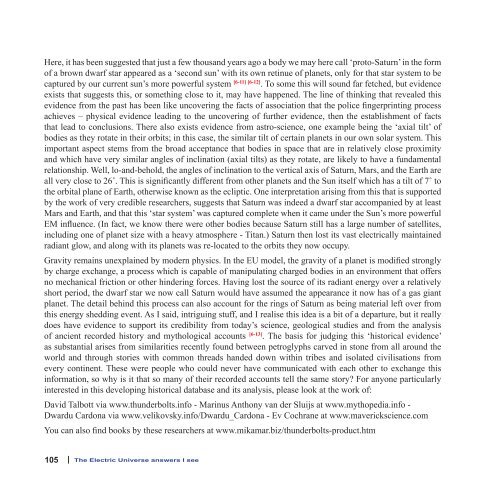A Beginner's View of Our Electric Universe - New
A Beginner's View of Our Electric Universe - New
A Beginner's View of Our Electric Universe - New
You also want an ePaper? Increase the reach of your titles
YUMPU automatically turns print PDFs into web optimized ePapers that Google loves.
Here, it has been suggested that just a few thousand years ago a body we may here call ‘proto-Saturn’ in the form<br />
<strong>of</strong> a brown dwarf star appeared as a ‘second sun’ with its own retinue <strong>of</strong> planets, only for that star system to be<br />
captured by our current sun’s more powerful system [6-11] [6-12] . To some this will sound far fetched, but evidence<br />
exists that suggests this, or something close to it, may have happened. The line <strong>of</strong> thinking that revealed this<br />
evidence from the past has been like uncovering the facts <strong>of</strong> association that the police fingerprinting process<br />
achieves – physical evidence leading to the uncovering <strong>of</strong> further evidence, then the establishment <strong>of</strong> facts<br />
that lead to conclusions. There also exists evidence from astro-science, one example being the ‘axial tilt’ <strong>of</strong><br />
bodies as they rotate in their orbits; in this case, the similar tilt <strong>of</strong> certain planets in our own solar system. This<br />
important aspect stems from the broad acceptance that bodies in space that are in relatively close proximity<br />
and which have very similar angles <strong>of</strong> inclination (axial tilts) as they rotate, are likely to have a fundamental<br />
relationship. Well, lo-and-behold, the angles <strong>of</strong> inclination to the vertical axis <strong>of</strong> Saturn, Mars, and the Earth are<br />
all very close to 26˚. This is significantly different from other planets and the Sun itself which has a tilt <strong>of</strong> 7˚ to<br />
the orbital plane <strong>of</strong> Earth, otherwise known as the ecliptic. One interpretation arising from this that is supported<br />
by the work <strong>of</strong> very credible researchers, suggests that Saturn was indeed a dwarf star accompanied by at least<br />
Mars and Earth, and that this ‘star system’ was captured complete when it came under the Sun’s more powerful<br />
EM influence. (In fact, we know there were other bodies because Saturn still has a large number <strong>of</strong> satellites,<br />
including one <strong>of</strong> planet size with a heavy atmosphere - Titan.) Saturn then lost its vast electrically maintained<br />
radiant glow, and along with its planets was re-located to the orbits they now occupy.<br />
Gravity remains unexplained by modern physics. In the EU model, the gravity <strong>of</strong> a planet is modified strongly<br />
by charge exchange, a process which is capable <strong>of</strong> manipulating charged bodies in an environment that <strong>of</strong>fers<br />
no mechanical friction or other hindering forces. Having lost the source <strong>of</strong> its radiant energy over a relatively<br />
short period, the dwarf star we now call Saturn would have assumed the appearance it now has <strong>of</strong> a gas giant<br />
planet. The detail behind this process can also account for the rings <strong>of</strong> Saturn as being material left over from<br />
this energy shedding event. As I said, intriguing stuff, and I realise this idea is a bit <strong>of</strong> a departure, but it really<br />
does have evidence to support its credibility from today’s science, geological studies and from the analysis<br />
<strong>of</strong> ancient recorded history and mythological accounts [6-13] . The basis for judging this ‘historical evidence’<br />
as substantial arises from similarities recently found between petroglyphs carved in stone from all around the<br />
world and through stories with common threads handed down within tribes and isolated civilisations from<br />
every continent. These were people who could never have communicated with each other to exchange this<br />
information, so why is it that so many <strong>of</strong> their recorded accounts tell the same story? For anyone particularly<br />
interested in this developing historical database and its analysis, please look at the work <strong>of</strong>:<br />
David Talbott via www.thunderbolts.info - Marinus Anthony van der Sluijs at www.mythopedia.info -<br />
Dwardu Cardona via www.velikovsky.info/Dwardu_Cardona - Ev Cochrane at www.maverickscience.com<br />
You can also find books by these researchers at www.mikamar.biz/thunderbolts-product.htm<br />
105 | The <strong>Electric</strong> <strong>Universe</strong> answers I see


